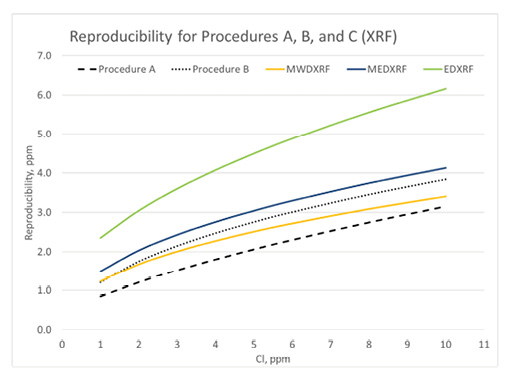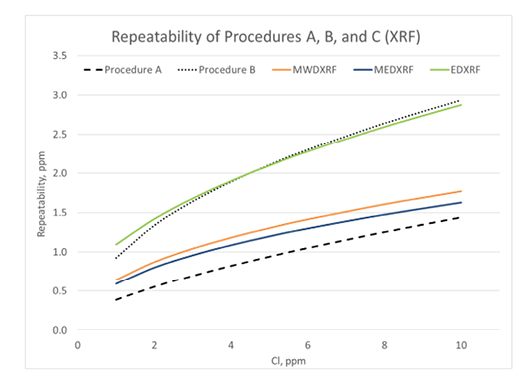- Analyzers
- Optics & Sources
- Technologies
- Support
- About
ASTM Approves D4929C
Standard Test Method for Determination of Organic Chloride Content in Crude Oil
by Distillation and XRF
Figure 1: D4929 Reproducibility

On October 15, 2017, ASTM approved the addition of Procedure C to D4929 Standard Test Method for Determination of Organic Chloride Content in Crude Oil. Procedure C uses X-ray Fluorescence (XRF) to determine the chlorine content in the crude oil naphtha fraction. This is an important step forward, as users will be able to officially use XOS’ Clora, Clora 2XP, and Sindie +Cl analyzers for organic chloride analysis in crude oil without ASTM method modification.
Traditionally, users of D4929 distill a crude oil sample to 400°F, wash the resulting naphtha fraction by caustic to remove H2S and then water to remove inorganic chlorides, and then use Procedure A or Procedure B to determine chloride content. Chloride content of the crude is then determined by back calculation. Procedure A determines chloride content by sodium biphenyl reduction followed by potentiometry, and Procedure B uses combustion and microcoulometry to determine chloride content in the naphtha fraction.
Figure 2: D4929 Repeatability

Procedure C test method precision was determined by an interlaboratory study (ILS) designed to replicate the original D4929 Precision A and B ILS. Eight ILS participants distilled ten crude oil blends of varying nominal organic chloride concentrations in blind duplicate, and the resultant naphtha cuts were washed and analyzed by multiple XRF techniques.The Procedure C precision varied by XRF type, and as a result there are separate precision statements for MWDXRF, MEDXRF, and EDXRF. Figures 1 and 2 compare the calculated precision statements obtained from the Procedure C study with the original Procedure A and B precision statements.
Figure 1 illustrates the calculated reproducibility for all D4929 procedures using the published precision statements in D4929. It demonstrates that Clora (MWDXRF) has better reproducibility than the other Procedure C XRF techniques and exhibits equivalent or better reproducibility than Procedure B (microcoulometry). In a recent review of the ASTM crude oil proficiency testing program, Procedure B is the most commonly used procedure for organic chloride analysis, though this may change with the addition of Procedure C to D4929. Figure 2 illustrates the calculated repeatability for all of the D4929 procedures, and Procedure C MEDXRF and MWDXRF (Clora) consistently exhibit better repeatability than Procedure B.
The addition of Procedure C to D4929 provides a precise, easy to use alternative to Procedures A and B. Clora, Clora 2XP, and Sindie +Cl analyzers comply with D4929 Procedure C. Contact XOS for more information.

